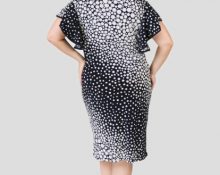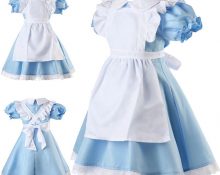
creativecommons.org
An Anna Karenina-themed historical society ball or just a fancy carnival? A bustle dress is guaranteed to attract attention and make you the center of attention. In this material we will tell the story of this unusual dress and describe step by step the process of sewing such an outfit. By tradition, at the end of the material you will find a pattern that will help you sew this unusual suit for yourself or for a model.
What is a bustle and what does it look like?
A bustle is an additional structure for a dress, which was attached to the back and created a certain silhouette with a sharp difference between the waist, tightened in a tight corset, and the hips, complemented by a bustle. The bustle consisted of special fabric pads and metal inserts attached to the back of the dress.Despite the fact that the bustle was actually at the height of fashion only from 1870 to 1880, almost everyone is familiar with this element of clothing: the figured silhouette was formed by tight corsets, which created additional volume at the back of the bustles and trains with a long lace overlay, nicknamed “ fish tail".
History of the bustle dress

Most people associate dresses with bustles with the second half of the 19th century. The word “tournure” itself comes from the French “tournure”, which translates as “manner of holding oneself”. According to one version, it was the overlay in the form of a bustle that made it possible to visually improve posture and, given the diminutiveness of French women, to achieve the illusion of splendor. Lush dresses with farthingales and crinolines were replaced by more compact, but no less layered and richly decorated dresses with bustles, ruffles, frills and lace additions. Bust dresses came into fashion in France, as did many other trends of the era. Wits immediately began to call this innovation nothing less than “the backside of Paris.” It all started in the 1870s, when fashion designer and fashion house founder Charles Frederick Worth created this silhouette and made it popular among ladies throughout Europe. According to legend, the very idea of such an addition to the dress arose when he saw a woman sweeping the floor who, for the sake of convenience, turned the hem of her skirt back. But fashion historians suggest that Worth is being disingenuous and picked up this idea from the historical costumes of the Rococo era, when similar polonaise dresses with lush fabric drapery on the back of the dress were in fashion. In part, this fashion was returning to the 1860s and was a harbinger of the trend for bustle dresses. Beginning in the 1870s, voluminous overlays appeared under the draped fabrics of Charles Worth dresses.The skirt itself often tapers towards the bottom, where it smoothly flows into a widening train. Most often, the skirt of the dress is decorated with additional lace, ruffles and lace stripes. Not everyone liked the new hypertrophied fashion: caricatures began to appear, hinting that a cup with a saucer and a teapot could easily be placed on the resulting ledge.
Another reason for jokes was the sound that multi-layered fabrics made when walking - a sound vaguely reminiscent of the sound combination “fru-fru”. By the way, in conversation, the bustle was most often called this very word, associated with the sound of rustling silk. So, probably, everyone who read “Anna Karenina” by Leo Tolstoy remembers that Vronsky’s horse was called “Frou-frou,” but not everyone understood the poetry of this animal’s name. Gradually, the owners of bustle dresses themselves began to be called Frou-Frou, so Ludovic Halévy and Arnie Meliyak wrote the play “Frou-Frou” about a socialite, who was played by Sarah Bernhardt herself in one of the productions.
By the mid-1880s, bustles begin to decrease in size, narrow and gradually deflate. But the train, on the contrary, lengthens. The pads themselves are becoming lighter: now they are not heavy rollers, but relatively small pads made of thin steel wire. The trend for bustle dresses continued into the 1890s, but were replaced by small quilted horsehair cushions in the early 1900s. In general, the fashion for an emphasized S-shaped silhouette continued for a long time, right up to the 1920s.
Historians believe that the fashion for dresses with bustles has become obsolete due to the development of transport: the fact is that it is absolutely impossible to get on a train, tram or bicycle in any kind of voluminous dresses. More precisely, it is possible, but then the appearance of the dress will not change for the better.And the ladies had to stand in the literal sense of the word “because the tailor did not order them to sit.”
In the 1960s and 70s, bustle dresses again became a topic of discussion, but it was more of a metaphorical rather than an actual comeback. Parisian illustrator Rene Guro is inspired by the outfits of that time and actively used them in his work. So, ladies in bustle dresses became his calling card. Dior and Valentino drew attention to the talented artist, and fashion publications Vogue and L’Officiel regularly published Guro’s illustrations on their pages, but the emerging trend for bustles remained on the catwalks, drawings and pages of magazines.
What you need to sew a dress with a bustle
- Large piece of plain fabric. If you are a beginner or do not have much experience, it is better to choose fabrics that are easy to sew and avoid taffeta, silk and satin.
- Sewing supplies (needles, threads, pins, chalk for marking, etc.).
- The pattern is presented at the end of this article.
- Wire.
- Ready-made pillows, small pieces of neutral-colored quilt, or even cotton rolls.
- Lace.
Step-by-step sewing of a dress with a bustle
You should immediately keep in mind that sewing a dress with a bustle involves a lot of work. This product will require time, patience and certain skills from the craftswoman. If the dress will be worn to a ball and not to a performance, it is worth working separately on the internal seams and making the design as light as possible for ease of movement. A classic bustle is an additional skirt that reaches to the knee, with voluminous pleats and ruffles at the back.
- Adjust the patterns to the model's parameters.
- Using pins, secure the pattern to the fabric, following the position of the grain thread.
- Sew the main parts of the skirt and bodice using a running stitch.
- Try the resulting shape on a model. The dress should fit snugly enough to the silhouette and hold the additional bustle skirt.
- Adjust the pattern if necessary and finish stitching the pieces.
- Now you can start the tournament. Secure the drapery with pins or baste it to the rough.
- Try on the resulting structure, placing the required number of bolsters or pillows under it. If these additional elements are missing or not yet ready, you can see how the finished product will look by placing crumpled newspaper under the drapery (poor or thrifty ladies in the 19th century also sometimes used newspaper instead of the traditional roller stuffed with horsehair).
- Adjust the drapery if necessary and sew all folds with a regular stitch.
- If desired, you can complement the skirt with a lace train.


 0
0





